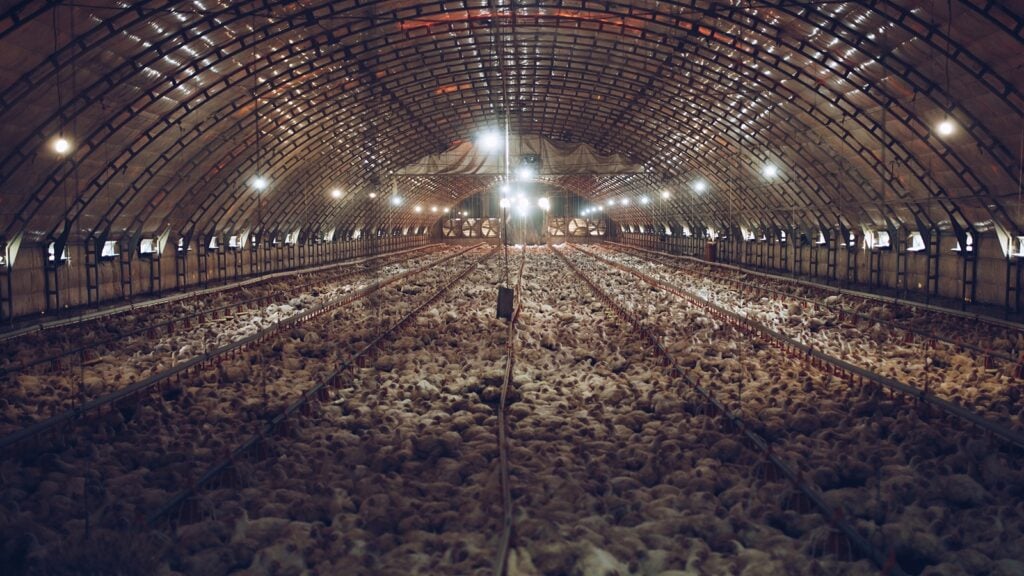It will be cost not kindness that ends animal agriculture – but when will we achieve vegan meat price parity?
As much as we care for animals, it’s likely that “price parity” between plant-based and animal-derived meats will see the quickest changes made to our food system
We love cheap food. When asked, we nearly always say we prefer to buy products that are ethical, sustainable, and healthy. But research shows time and again that what actually drives most of our food choices are cost, convenience, and taste.
Most of all, it’s the price.
Vegan meat price parity
That’s why the question of price parity is a hot topic in plant-based food. With price, especially a cheap price, such a driving force in our food choices, the cost of plant-based meats really matters.
Right now, supermarket customers are paying almost 200 percent more for plant-based products in comparison to meat alternatives.
It’s also why the European dairy lobby is trying to stop plant-based products being sold in “dairy” packaging. If plant-based providers have to use different packaging, this could make plant-based alternatives more difficult to produce and, critically, more expensive to buy.
But lessons from other industries (such as electric cars) show that as technology develops and demand increases, price parity will arrive. But for plant-based meat products, when will that be? Can it really bring an end to the slaughter-based meat products that are currently cheaper and purchased more often?
‘Cheap food paradigm’
We love cheap food. As the UK government’s Behavioral Insights Team wrote in their report A Menu For Change, price (alongside convenience and taste) is the most important factor for people when shopping. This includes for healthier alternatives.
This isn’t our fault. Supermarkets, advertising, and government policies have spent 70 years creating what food expert Professor Tim Lang calls our “cheap food paradigm.”
This is especially in the UK and US. Along with Singapore, these are the three cheapest food markets in the world. In the UK, we spend only eight percent of our household budget on food. This is the cheapest in Western Europe. Greeks spend 16 percent, Peruvians 26 percent, and Nigerians 59 percent.
But when you learn that the UK also has the highest food poverty in Europe in terms of people being able to afford a healthy diet, you know something is wrong.
This cheap food paradigm emerged during World War 2. Farmers were asked to grow more food, quickly and cheaply. They were the heroes feeding a country at war, and rebuilding afterward.
Farmers were doing what they were asked. They began using heavy chemicals and pesticides. They abandoned rotation farming and replaced them with monocultures. Food got increasingly cheap. There were supermarket price wars (continuing today). We lost touch with the true cost of food.
But at what cost?
The true cost of cheap food is a “spiraling public health crisis and environmental destruction” – according to the RSA’s Food, Farming and Countryside Commission.
Last month’s Chatham House/UN report drove home the point: “Cheap food is driving destruction of the natural world.” The constant demand for economic growth has “sustained vicious circles” of agricultural efficiency, coupled with “increased economic competition through the liberalization of trade.”
Cheap foods also tend to be more processed. In the UK, we eat the most ultra-processed foods in Europe, nearly 50 percent of our diets. Compare this to around 11 percent in Italy or 16 percent in Portugal. This massively increases the incidence of Type-2 diabetes and other serious health epidemics.
A price transformation
It’s obvious we need a food transformation. And that includes the price we pay for it.
What we should do is ask those who can afford more to pay more, while supporting those currently in food poverty to be able to buy better. But that’s another article!
We also know that a whole-foods plant-based diet can be much cheaper than a heavily processed, animal-based diet.
Right now, most meat-eaters overestimate the price of plant-based meat products. And they’re not wholly wrong.
So if we want to see change happen quickly, we have to get people off the slaughter-based meats and into the plant-based aisles. The quickest way to do that is through pricing.
So when will that happen? It will arrive in three stages.
By 2023: Affordable plant-based protein
Back in 2019, the independent think tank Rethink X launched its report on the future of agriculture.
Its analysis suggested that price parity between existing plant-based meats (for example, the Impossible Burger) and animal-derived meats would arrive sometime between 2021-23.
When this happened, it wrote, adoption of more plant-based eating “will tip and accelerate exponentially.”
It is why companies such as Impossible Foods keep slashing their prices to drive demand, knowing that “price parity” will increase not only sales but awareness and acceptability.
Are we close to the tipping point?
At the moment, buying a vegan supermarket product twice a week would cost an additional £35 a year, a spokesperson for Insure4Sport, who produced research on cost comparisons, told The Times.
Right now, the early-adopter vegan and vegetarian or adventurous meat-eater will pay the premium price for the new plant-based alternatives. That won’t last.
The plant-based producers know they need to compete on price. Demand is growing. In 2019, demand for plant-based meats grew by 18 percent and 11 percent for the plant-based category overall, according to a study from The Good Food Institute.
More people than ever now support improved access to plant-based options. New research last week from The Vegan Society showed one in three (32 percent) believe the government should be promoting vegan and plant-based diets to address the current climate emergency.
Bill Gates recently urged people to buy plant-based products and drive down the price. “You can also send a signal to the market that people want zero-carbon alternatives and are willing to pay for them,” he told the BBC.
The supermarkets will drive this difference. If Tesco is setting a target for a 300 percent rise in vegan meat sales, it will still want to compete on price.
So perhaps Rethink X’s prediction that we will reach price parity for existing products by 2023 isn’t far off.
But what about the new world of cell-cultured meat, grown in a lab?
By 2030: Cultured protein
Cell-cultured meat is real meat or dairy but without the animal. It is grown or fermented in vats or produced in other ways without needing animals to die.
(There is controversy around this claim: early production used serum from slaughtered calves. But new procedures are being developed without any animal deaths.)
Rethink X also predicted there would be 50 percent fewer cows in American agriculture by 2030. It predicted once cows disappeared in America, the rest of the world—and the other animal industries, such as pork and chicken—would follow.
The cause? Not ethics, but technology.
Or rather, what it calls “a protein disruption driven by economics.” In its new “cell-cultured” technologies producing meat and dairy products in labs, would produce “proteins five times cheaper by 2030 … than existing animal proteins.”
This report was theoretical. Was it simply wishful thinking?
Competing on costs
Well, two new studies published earlier this month think it is going to happen by 2030. These studies are based on actual data from existing protein producers.
This research, from the Good Food Institute, suggests “cultivated meat could compete on costs and have a lower environmental footprint compared to conventional meat production in under 10 years.”
The figures are astounding. The life cycle assessment and techno-economic assessment suggest when compared with beef from cows, cultivated meat will produce 92 percent less global warming gases and 93 percent less air pollution, using 95 percent less land. If renewable energy is used, then 78 percent less water is needed too.
And the coronavirus has only made animal agriculture more expensive, as well as highlighted its critical role as a breeding ground for zoonotic pandemics.
So plant-based burger price parity by 2023. Then cell-cultured burgers by 2030.
By 2035: The end of animal products?
Rethink X argued that not only will we achieve price parity, but that by 2035 cell-based and plant-based alternatives will be 10 times cheaper than defunct animal-derived products.
Motivated by price, it suggests the average family will save more than $1,200 in food costs.
But also, these slaughterless proteins will be superior too: “More nutritious, healthier, better tasting, and more convenient, with almost unimaginable variety… modern food products will be higher quality and cost less than half as much to produce as the animal-derived products they replace.”
The research commissioned by the Good Food Institute seems to suggest we’re moving in this direction.
From an ethical point of view, as plant-based and slaughter-free foods become the norm, people will be free to wonder how we ever used to kill so many animals, at such a horrific cost.
A long way to go
We’re not there yet. But as individual consumers, buying plant-based alternatives will drive up demand and drive down the cost, meaning regular meat-eaters will pick them up too.
According to YouGov, nearly a quarter of diehard meat-eaters say they enjoy meat-alternatives. If we make it easier for them on price, that figure will only increase.
We can work together as citizens to put collective pressure on the government. Not least to take up the recommendations in its own Behavioral Insights Team’s report!
Actions such as incentivizing product innovation, a carbon tax, raising awareness, and creating real value for farmers for their food, will all help reshape our ‘cheap food paradigm’. Then we’ll reach price parity sooner.
So keep buying those sausage, burger, and chicken alternatives. Every time you do, you tell the companies there’s a market.
Whether it’s 2023 or 2030, price parity will arrive. Then, plant-based meats will be cheaper. When that happens, with all their inherent costs and environmental impacts, animal-derived and slaughter-based meats won’t be able to compete.
We’re more than consumers of course. But this really is one way we can help shape the future.






